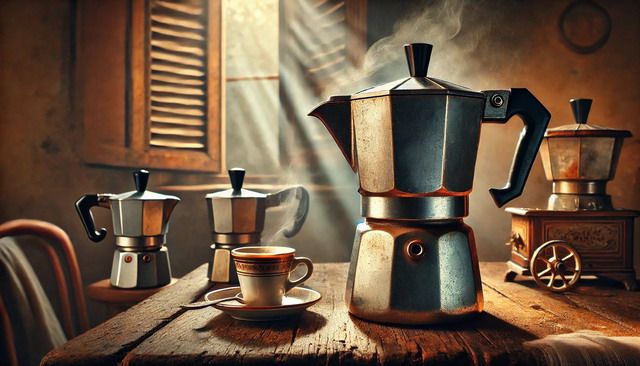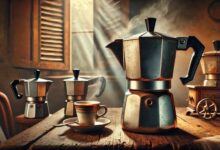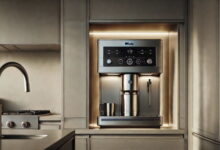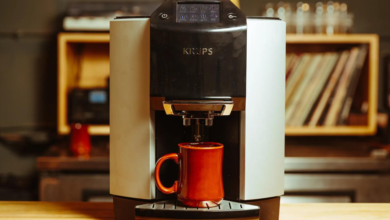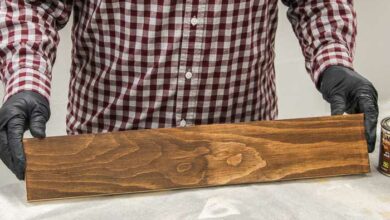Best Vintage Espresso Maker for Authentic Coffee Lovers
Vintage Espresso Maker
For coffee enthusiasts and collectors alike, owning a vintage espresso maker offers a unique blend of aesthetic appeal, history, and hands-on craftsmanship. Unlike their modern, fully-automated counterparts, these machines require a certain level of engagement, rewarding those willing to master their intricacies with rich, authentic espresso. As more people seek a deeper connection to their coffee ritual, the allure of these classic machines continues to grow.
In this article, we will explore what makes a vintage espresso maker so special, from their history and iconic models to restoration and maintenance tips. Whether you’re considering adding a piece of coffee history to your home or are simply curious about the resurgence of these machines, we’ll guide you through the fascinating world of vintage espresso makers.
What is a Vintage Espresso Maker?
The allure of vintage espresso makers has captured the hearts of coffee enthusiasts and design lovers alike. But what exactly is a vintage espresso maker, and why has it become such a coveted item in recent years?
At its core, a vintage espresso maker refers to any espresso machine manufactured during the mid-20th century or earlier. These machines, crafted primarily from metal and designed with mechanical precision, stand in stark contrast to the sleek, high-tech espresso makers of today. Vintage espresso makers were built to last, and many of them continue to function decades after their initial production, a testament to their durability and the artisanal craftsmanship that went into their creation.
A Brief History of Espresso Machines
The story of espresso machines began in Italy in the late 19th century when the need for a faster way to brew coffee became apparent. Before the invention of the espresso machine, coffee was brewed using methods that took considerable time and lacked consistency in flavor and strength. Angelo Moriondo is credited with creating the first espresso machine in 1884. His invention used steam to force water through ground coffee, creating a quick, concentrated brew.
However, it wasn’t until 1901 that Luigi Bezzera patented improvements to Moriondo’s design, bringing us closer to what we now recognize as the espresso machine. Bezzera’s machine, further refined by Desiderio Pavoni in 1905, introduced key features such as the steam wand and the pressure gauge. This was the birth of the modern espresso culture in Italy, which quickly spread to other parts of Europe.
The machines from this era were large, ornate, and often powered by steam pressure. Their designs were as much a statement of elegance as they were functional. Early models, like the iconic La Pavoni and Gaggia machines, are now considered works of art, blending beauty with mechanical precision.
As espresso machines evolved through the 20th century, they became more compact, accessible, and electric-powered, yet many enthusiasts still believe the craftsmanship and tactile experience of using a vintage machine are unmatched.
The Appeal of Vintage Espresso Makers
So, why have vintage espresso makers become so popular in recent years?
For one, there’s the undeniable aesthetic charm. Vintage machines, with their gleaming chrome exteriors, rounded curves, and retro design elements, evoke a sense of nostalgia. They harken back to a time when items were made with a sense of permanence, built to last a lifetime or longer. In an era where mass production often prioritizes cost over quality, these machines represent an investment in beauty and functionality.
But the appeal of vintage espresso makers goes beyond mere aesthetics. Many coffee aficionados believe that these older machines produce superior espresso. This is due to the mechanical nature of vintage machines, which often rely on levers or steam pressure rather than the automated systems found in modern machines. With a vintage espresso maker, the user has more control over the brewing process—everything from the water temperature to the pressure applied to the coffee grounds can be adjusted manually. This results in a more personalized, hands-on brewing experience that many consider to be the hallmark of a truly excellent espresso.
Evolution and Key Characteristics
One of the defining characteristics of a vintage espresso maker is its manual operation. Unlike modern machines, which rely on digital interfaces and automatic settings, vintage espresso makers often require a more hands-on approach. For example, the iconic lever espresso machines, such as the La Pavoni Europiccola, rely on the user’s physical effort to pull a lever, forcing water through the coffee grounds at just the right pressure.
These machines are often made from high-quality materials such as brass, copper, and stainless steel, which not only contribute to their longevity but also enhance the flavor of the coffee. Many vintage espresso makers were designed with aesthetics in mind as well, featuring ornate details and luxurious finishes that make them stand out in any kitchen or café.
Another key feature of vintage machines is their ability to maintain stable temperatures. Unlike many modern machines, which can fluctuate in temperature, vintage espresso makers often have heavy-duty boilers or heat-exchange systems that ensure consistent brewing temperatures. This stability is crucial for achieving the perfect extraction of coffee oils and flavors.
Best Vintage Espresso Makers of All Time
When it comes to vintage espresso makers, a few brands and models stand out above the rest. These machines have not only stood the test of time but have also become iconic symbols of espresso culture. Let’s take a closer look at some of the best vintage espresso makers of all time.
- La Pavoni Europiccola
The La Pavoni Europiccola is perhaps the most iconic vintage espresso maker in existence. First introduced in 1950, the Europiccola remains one of the most sought-after manual lever machines. Its design is sleek, with a chrome or brass finish that exudes elegance. What sets this machine apart is its simplicity and functionality. With just a few components, the Europiccola allows users to control every aspect of the brewing process, from the grind size to the water temperature and pressure.
La Pavoni machines are known for their durability, and many models from the 1950s are still in use today. The Europiccola’s lever system requires a bit of practice to master, but once you get the hang of it, you can produce espresso shots that rival those made with modern machines. The tactile nature of the brewing process is part of its appeal—pulling a perfect shot of espresso with a La Pavoni feels like an accomplishment.
- Faema E61
Another legendary name in the world of vintage espresso machines is the Faema E61, first introduced in 1961. This machine revolutionized the espresso industry by introducing a pump-driven system that allowed for more consistent and efficient espresso extraction. The E61’s iconic design, with its large, gleaming chrome body and rounded edges, is a favorite among collectors and baristas alike.
One of the key innovations of the Faema E61 was its heat-exchange system, which allowed for continuous brewing without fluctuations in temperature. This ensured that each shot of espresso was brewed at the optimal temperature, resulting in consistently excellent espresso. Even today, many modern machines borrow design elements from the E61, a testament to its lasting influence on the industry.
- Gaggia Classic
The Gaggia Classic, originally launched in the 1970s, is another vintage machine that continues to be revered by espresso enthusiasts. Known for its sturdy construction and reliable performance, the Gaggia Classic offers the perfect balance between simplicity and functionality. The machine’s design has changed little over the years, and it remains a popular choice for home baristas looking to replicate the experience of using a professional espresso machine.
The Gaggia Classic features a professional-grade portafilter and steam wand, allowing users to create café-quality espresso and milk-based drinks at home. Its solid build and classic design have made it a favorite among those who appreciate both form and function.
In the world of espresso, vintage machines hold a special place, offering not just coffee, but a connection to the history, craftsmanship, and artistry of espresso making. Whether it’s the tactile pleasure of pulling a lever or the aesthetic joy of admiring a beautifully crafted machine, owning a vintage espresso maker is more than just a way to brew coffee—it’s an experience.
Restoring a Vintage Espresso Maker
The appeal of vintage espresso makers lies in their timeless design, impeccable craftsmanship, and the nostalgia they invoke. However, acquiring one often means inheriting years of wear and tear. Restoring a vintage espresso maker can be a rewarding experience, transforming a piece of history back to its former glory and ensuring it serves up perfect espresso for years to come.
Steps and Tools Needed for Restoration
Restoring a vintage espresso machine requires a bit of patience, mechanical skill, and the right tools. While the complexity of the restoration can vary depending on the condition of the machine, there are some basic steps that apply to most vintage espresso makers.
- Assessment and Disassembly The first step is to assess the overall condition of the machine. Look for signs of rust, corrosion, broken parts, and any missing components. This will help you decide what needs to be repaired or replaced. Disassemble the machine carefully, taking photos of each step so you can easily reassemble it later. Many vintage machines, such as the La Pavoni Europiccola, have relatively simple internal mechanisms, which makes them easier to work on compared to modern electronic machines.
- Cleaning and De-scaling Over time, espresso machines accumulate limescale from water deposits, which can affect the machine’s performance. Use a de-scaling solution specifically designed for espresso machines to clean the boiler and internal piping. For external components, use mild detergents and non-abrasive brushes to clean away grime and coffee residue. Avoid using harsh chemicals, especially on chrome or brass finishes.
- Rust Removal and Polishing If the machine has any rust, it must be removed to prevent further damage. Rust can usually be eliminated using a combination of steel wool and specialized rust removers. Once the rust is gone, polish the machine using metal polish to restore its original shine. This step can be particularly satisfying, as it brings back the machine’s original luster.
- Replacing Seals and Gaskets One of the most common issues with vintage espresso machines is the degradation of rubber seals and gaskets. Over time, these components harden or crack, leading to leaks and poor pressure control. Fortunately, many of these parts are still available from specialty suppliers or can be custom-made. Replacing old seals and gaskets is essential to ensure your machine functions properly.
- Reassembling and Testing After cleaning and repairing, reassemble the machine carefully. Double-check all connections and make sure no parts are missing. Fill the machine with water and test it. Pay attention to the pressure, temperature, and overall functionality. It may take a few attempts to fine-tune the machine, but once restored, a vintage espresso maker can function just as well as, if not better than, a modern machine.
Common Issues and How to Fix Them
While restoring a vintage espresso maker can be straightforward, some issues may arise that require special attention:
- Corrosion in the Boiler: In older machines, especially those made of brass or copper, corrosion in the boiler is common. If the corrosion is superficial, it can often be cleaned with an acidic solution. In severe cases, the boiler may need to be replaced.
- Broken Heating Element: If the machine doesn’t heat up, the heating element might be faulty. Replacements for some vintage models are still available, though installing them might require professional help.
- Pressure Problems: If your machine can’t maintain pressure, it’s usually due to worn-out seals or a malfunctioning pressure gauge. Replacing the gaskets and ensuring the pressure gauge is calibrated correctly can resolve this.
Restoring a vintage espresso machine is as much an art as it is a science. With time and effort, you can return these beautiful machines to their full glory and enjoy espresso made with a true piece of history.
Where to Buy Vintage Espresso Makers
Owning a vintage espresso maker is a dream for many coffee enthusiasts, but finding a high-quality, authentic machine can be a challenge. Fortunately, there are several places where you can purchase vintage espresso makers, ranging from online marketplaces to specialty stores. Knowing where to look and what to watch for can help you find the perfect vintage machine.
Online Platforms for Vintage Espresso Machines
- eBay eBay is one of the most popular platforms for finding vintage espresso makers. It offers a wide range of machines from different eras, brands, and conditions. Many sellers on eBay specialize in vintage appliances, and you can often find rare models that are difficult to source elsewhere.
When purchasing from eBay, it’s important to thoroughly read the listing descriptions and ask the seller for additional photos if necessary. Look for sellers with positive feedback and detailed descriptions of the machine’s condition. Be prepared to bid competitively if you’re eyeing a rare model, as these can attract collectors from around the world.
- Etsy While Etsy is better known for handmade goods, it also has a large selection of vintage items, including espresso machines. Etsy sellers often take great care in curating their listings, and you may find some unique and restored machines. Because Etsy sellers tend to specialize in niche markets, it can be a great place to find restored machines or custom modifications.
- Specialty Coffee Shops and Collectors Some coffee shops and retailers specialize in vintage espresso machines. These shops often restore machines before selling them, ensuring that you’re getting a functional piece of history. Buying from a specialty shop may cost more than purchasing from an individual seller, but the peace of mind that comes with knowing the machine has been professionally restored is worth it for many buyers.
- Auctions and Collector Markets Vintage espresso makers sometimes appear at estate sales, auctions, and collector markets. These events can be a great way to find rare models that aren’t listed online. However, it’s important to do your research and know the market value of the machine you’re interested in. Auctions can get competitive, and it’s easy to get caught up in the excitement of bidding.
Tips for Spotting Quality Machines
When shopping for a vintage espresso maker, it’s essential to know what to look for to avoid scams or purchasing a machine that is beyond repair. Here are a few tips:
- Condition: Always check the condition of the machine. Look for signs of rust, corrosion, or missing parts. Machines that have been poorly maintained or stored improperly may be difficult or expensive to restore.
- Brand Reputation: Stick to well-known brands like La Pavoni, Faema, and Gaggia, as these companies have a history of producing high-quality machines. Parts for these brands are also easier to find if you need to restore the machine.
- Authenticity: Be wary of counterfeit machines or replicas. Look for manufacturer markings, serial numbers, and other identifying details that confirm the machine’s authenticity.
Price Range and Value
The price of a vintage espresso machine can vary widely depending on factors like age, brand, condition, and rarity. Machines that are in good working condition or have been professionally restored can fetch a premium price, often ranging from $500 to several thousand dollars. Rare models, especially those with historical significance, can command even higher prices at auctions or from collectors.
Machines that require significant restoration work are typically more affordable, sometimes costing as little as $200. However, the cost of repairs and replacement parts can quickly add up, so it’s important to factor these expenses into your budget.
How to Maintain a Vintage Espresso Maker
Once you’ve restored or purchased your vintage espresso maker, proper maintenance is key to ensuring its longevity. Regular care and attention will not only keep your machine functioning smoothly but will also preserve its aesthetic appeal.
Daily Cleaning Tips
- Flush the Group Head: After every use, flush the group head with hot water to remove any coffee grounds or oils that may have accumulated.
- Wipe Down the Exterior: Use a soft, damp cloth to clean the exterior of the machine. Avoid using abrasive materials that could scratch the finish.
- Empty the Drip Tray: Empty and clean the drip tray daily to prevent water buildup and potential rust.
Monthly Maintenance
- Descaling: Over time, minerals from water can build up inside the machine, affecting its performance. Descaling once a month using a solution designed for espresso machines will help prevent this.
- Gasket Replacement: Check the gaskets for wear and tear. Depending on usage, gaskets may need to be replaced every six months to a year.
Expert Tips for Preserving the Machine
- Use Filtered Water: Using filtered or distilled water can reduce mineral buildup inside the machine, prolonging the time between descaling sessions.
- Store in a Dry Place: If you don’t use your machine daily, store it in a dry area to prevent rust and corrosion.
- Regular Tune-ups: If you’re not comfortable performing more advanced maintenance yourself, consider taking your machine to a professional for regular tune-ups.
With the right care and maintenance, a vintage espresso maker can continue to produce excellent coffee for decades, and in some cases, become a valuable heirloom.
Why Choose a Vintage Espresso Maker Over a Modern One?
As the coffee culture continues to thrive, the debate between vintage and modern espresso machines has gained momentum. While modern espresso machines offer convenience, automation, and high-tech features, there’s a growing community of coffee enthusiasts who prefer the hands-on experience and charm of vintage espresso makers. So why would someone choose a vintage espresso maker over a brand-new, high-end model? Let’s explore the reasons.
- Aesthetic Appeal and Craftsmanship
One of the most compelling reasons to choose a vintage espresso maker is its aesthetic appeal. Unlike many modern machines that prioritize functionality over form, vintage machines were often designed to be as beautiful as they were practical. They feature intricate details, chrome finishes, and sleek, retro designs that can serve as both a coffee maker and a conversation piece in your kitchen or café.
Vintage espresso makers are often associated with high-quality craftsmanship. Brands like La Pavoni, Faema, and Gaggia built their machines to last for decades, using materials such as brass, copper, and stainless steel. In contrast, many modern machines, especially in the lower price ranges, rely on plastic components that may not stand the test of time. A vintage machine is not just a functional appliance; it’s a work of art that embodies the spirit of a bygone era when things were built to last.
- Control Over the Brewing Process
For those who enjoy being fully involved in the brewing process, vintage espresso machines provide an unmatched level of control. Many vintage models, especially lever machines like the La Pavoni Europiccola, allow the user to manually control every aspect of the brewing process, from the pressure to the timing of the extraction. This level of involvement gives the user the opportunity to experiment with different brewing variables, tailoring each shot of espresso to their exact preferences.
While modern machines with digital interfaces and pre-programmed settings are convenient, they don’t always offer the same level of customization. For coffee aficionados who enjoy the challenge of crafting the perfect shot, a vintage machine offers a more hands-on experience, making each cup of espresso a personal achievement.
- Durability and Longevity
As mentioned earlier, vintage espresso machines were built to last. Many machines from the 1950s and 1960s are still in excellent working condition today, a testament to the quality of their construction. With proper maintenance and occasional part replacements, a vintage machine can continue to function for many more years.
Modern machines, particularly those made with plastic components or low-cost materials, are often not as durable. While high-end modern machines can certainly be long-lasting, they come with a higher price tag and often involve complex electronics that can be difficult and expensive to repair. Vintage machines, by contrast, are relatively simple in their mechanical design, making them easier to repair and maintain over time.
- Sustainability
In an era where sustainability is becoming increasingly important, choosing a vintage espresso machine can be seen as a more eco-friendly option. By restoring and using an old machine, you are essentially recycling a piece of equipment that might otherwise have ended up in a landfill. Additionally, vintage machines are typically made of metal rather than plastic, making them more environmentally friendly in terms of their construction.
Many modern espresso machines, especially lower-end models, are mass-produced and often have a shorter lifespan. When these machines break down, they are frequently discarded rather than repaired, contributing to electronic waste. By choosing a vintage machine, you’re making a sustainable choice that reduces waste and conserves resources.
The Long-Term Value of Owning a Vintage Espresso Maker
While many people are drawn to vintage espresso machines for their aesthetic appeal and craftsmanship, there’s another significant benefit to owning one: long-term value. Vintage espresso makers are not only functional appliances; they can also be valuable collector’s items, especially if they are well-maintained and come from reputable brands.
- Investment Potential
As the popularity of vintage espresso makers continues to rise, so does their market value. Certain models, especially those from well-known brands like Faema, Gaggia, and La Pavoni, have become highly sought after by collectors and coffee aficionados alike. Machines that are in good condition, especially those that have been professionally restored, can command high prices in the resale market.
For example, a vintage Faema E61, which was revolutionary in its time for introducing pump-driven technology, can sell for several thousand dollars, depending on its condition and originality. Similarly, early models of the La Pavoni Europiccola or the Gaggia Classic are prized by collectors and can increase in value over time.
- Historical Significance
Vintage espresso machines are often appreciated not just for their functionality but also for their historical significance. Many of these machines were part of key innovations in the coffee world, representing milestones in the evolution of espresso culture. Owning a vintage machine means owning a piece of coffee history, which adds to its allure for collectors and enthusiasts.
For example, the Faema E61 is credited with revolutionizing the espresso industry by introducing a continuous brewing system, while machines like the La Pavoni Europiccola were among the first to bring the lever-operated espresso experience into the home. These machines are more than just tools for making coffee—they are symbols of innovation and craftsmanship.
- Rare and Highly Valued Models
Some vintage espresso machines are considered rare and have become valuable collector’s items. Machines that were produced in limited quantities, or those that feature unique design elements or special editions, can command significantly higher prices. For example, certain limited-edition models of the La Pavoni Europiccola with brass or copper finishes are highly sought after and can fetch premium prices at auctions or from specialty retailers.
Collectors also place a high value on machines that are in original condition, with all their original parts intact. Machines that have been heavily modified or repaired using non-original parts may be less valuable to collectors, though they can still be fully functional and produce excellent espresso.
Conclusion
Vintage espresso makers offer more than just a way to brew coffee—they provide a connection to the past, a tangible piece of history that blends form and function. Their timeless designs, high-quality craftsmanship, and hands-on brewing process make them an attractive choice for coffee lovers and collectors alike.
While modern machines may offer convenience and technology, there’s something undeniably special about the tactile experience of using a vintage machine. The meticulous restoration process, the control over every aspect of brewing, and the knowledge that you’re using a piece of coffee history make each cup of espresso more satisfying.
Whether you’re drawn to the investment potential, the sustainability factor, or the sheer beauty of these machines, owning a vintage espresso maker is an experience unlike any other. For those who appreciate the finer things in life, a vintage espresso maker offers a perfect blend of functionality, history, and artistry that is difficult to match in today’s fast-paced, technology-driven world.

